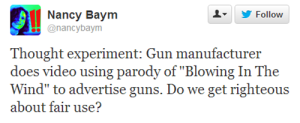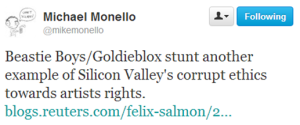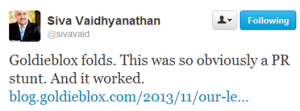-
Recent Posts
- My #SCMS16 Presentation – From Surplus Desire to Profit: Audiences, Consumption, and the Management of Desire
- My #ir16 presentation, The Internet Intellectual Property Imaginary: The Case of Fandom
- From Lesbian Sitcoms to Femslash Fandom: The Lesbian Continuum and #SwanQueen
- Blurred Lines, or: The Law Doesn’t Matter
- Once Upon a Rape Culture: @OnceABC and “No Means Yes”
Categories
Category Archives: industry
My presentation on the Industry Studies and/as Audience Studies panel #k19 at the 2014 Society for Cinema and Media Studies conference.
(RIP MCA)
Toy company Goldieblox recently released a video of girl children rejecting the narrow toy options available to them and instead engineering a Rube Goldberg machine out of typically feminine toys to the soundtrack of the Beastie Boys’ classic 1986 song “Girls,” rewritten to have pro-Girls-in-STEM lyrics.
Controversy ensued. It was seemingly contained to the feminist internet or the technology/copyright internet, and happening in parallel in them with little cross-pollination except for feminist copyright scholars, so those not hooked into those circuits of knowledge circulation may have missed it. (I’d embed or link to the video but it no longer exists in that form.)
I’ll admit that my first thought when I saw the video was “That’s so cool of the Beastie Boys to authorize this!”
I then immediately had to revoke my own scholar card, because the whole point of fair use is that copyright holders don’t have to authorize it.
But after I copied out Section 107 of the copyright code 50 times in penance, I kept reading the various takes on it that went across my Twitter feed. And this tweet
 from @nancybaym (retweeted to me by @mikemonello) was when I knew I had to write about it:
from @nancybaym (retweeted to me by @mikemonello) was when I knew I had to write about it:
This is an incredibly powerful example, and Baym is entirely right that such a parody would provoke horror in a lot of people (me included). And while in one sense it is a valid parallel, because it would involve a re-user producing a song dramatically opposite to the message of the original for the purposes of advertising, in another sense the two aren’t comparable at all.
A more powerful social position (pro-gun) co-opting a less powerful social position (pro-peace) just isn’t the same as a less powerful social position (pro-girl) co-opting a more powerful social position (wildly sexist). The Goldieblox controversy, that is, is a textbook example of the argument I’m starting to formulate: The meaning of an act of reuse depends on who’s doing it. (Not legally, of course, but culturally and maybe even morally.)
To know what to make of the Goldieblox “Girls” parody, then, “Who’s doing it?” is the key question.
Are they pro-girl transformative creators who only preemptively sued out of a need to protect themselves from beastly Beasties and their lawyers? (Also, is pre-emptive suing to have works declared non-infringing becoming more common [cf. Robin Thicke/Marvin Gaye], or am I just paying more attention now?) This is how their defenders and those focusing on the message of the video have portrayed it.
Or are the Goldieblox folks cynical opportunists who wanted to trade on the familiarity of “Girls” or the cognitive dissonance of the new lyrics against the misogynist original or who hoped there’d be attention-generating controversy?
My contention is that we get such wildly divergent responses to the piece because it’s not clear who’s doing it. Likely we’ll never be able to definitively answer that question, and in some sense they’re both of those things. Perhaps there’s an aspect of Rorschach testing here: What you see in this case indexes how you see the world generally.
However, Felix Salmon notes in the article linked by @mikemonello above, “Given the speed with which the GoldieBlox complaint appeared, indeed, it’s reasonable to assume that they had it in their back pocket all along, ready to whip out the minute anybody from the Beastie Boys, or their record label, so much as inquired about what was going on.”
This tips it much farther to the opportunist side—knowing about these legal machinations makes the “just pro-girl” reading much harder to sustain. But the feminist interpretation is still there, and it inclined a lot of people to support the video, even with the copyright infringement angle. Indeed, if Goldieblox had been less antagonistic there’s every chance the balance of support would have been in their favor.
But, as Salmon points out, “GoldieBlox neither sought nor received permission to create these videos: it never licensed the music it used from the artists who wrote it. That wouldn’t be the Silicon Valley way. First you make your own rules — and then, if anybody tries to slap you down, you don’t apologize, you fight.”
With further analysis, then, Goldieblox looks increasingly unlike an underdog.
In a Gigaom piece, (via @sivavaid), Jeff John Roberts says, “A quick visit to GoldieBlox’s website reveals terms of service that are about as reasonable as the Spanish Inquisition; the terms includes gems like this one: ‘We grant you a limited, non-exclusive, revocable, non-assignable, personal, and non-transferable license to create hyperlinks to the Website.’”
The idea that a hyperlink needs a license shows them to be a) unfamiliar with how the internet works, b) unfamiliar with standard conventions of writing offline or on, and c) copyright maximalists when it’s their stuff, i.e. hypocritical.
Roberts adds, “At the same time, the Beastie Boys themselves long-ago eschewed the sort of beer-swilling sexism of their debut album, and became advocates for women amidst a general hip-hop climate of misogyny.” So even as Goldieblox looks less good when you look more closely, the Beasties are less bad.
And this sort of nuance is exactly why I contend that we have to tease this stuff out, to parse as precisely as possible who’s doing what to who and how.
Corynne McSherry demonstrates in her analysis for the Electronic Frontier Foundation that the Goldieblox video is probably fair use by the four-factor test. However, if this cultural moment shows anything it’s that it’s the cultural lives of intellectual property (to use Rosemary Coombe’s title) that are far more interesting.
One set of intellectual-property scholars defends sampling in music, calling for expanding fair use to encompass all acts of sampling and arguing that we should do away with licenses and payments for such samples (Schumacher 1995, Vaidhyanathan 2003). This position tends to support sampling as a form of creativity in hip hop that’s grounded in African-origin practices and notions of creativity that should be seen as valid rather than marginalized by the currently hegemonic Western notion of the Romantic author who produces a unique creation out of his individual genius.
Another approach to musical reuse points to the history of white appropriation of both the African American blues tradition (Hesmondhalgh 2006, Vaidhyanathan 2003) and indigenous music (Feld 1988, Seeger 1992). These authors tend to argue for more protection against reuse rather than less, including the need to get permission and provide payment.
At least in my reading so far—and I freely acknowledge I’m early in this project—generally these two arguments happen in parallel (even with Vaidhyanathan who makes both). However, as is my wont, I think the answer to this either/or framework is “Yes.”
Reuse of existing musical material in new work is BOTH a valid way to produce new creative works that should be allowed and protected AND a new instantiation of old practices of cultural theft. This is because the same practice means something different depending on who does it (and so maybe isn’t “the same” after all).
That is, we have to think about and take seriously the social structures that condition the action of reuse and position the people who do it. In other words, I don’t think it’s a coincidence that 2 Live Crew provides foundational court cases for both Critical Race Theory and copyright scholarship. Nor is it just happenstance that in the 1991 case Grand Upright Music, Ltd. v. Warner Bros. Records Inc., the judge admonished Biz Markie “Thou shalt not steal” (Brennan Center for Justice 2005, Tushnet 2004)
2 Live Crew’s obscenity case (written about by Kimberlé Crenshaw in “Beyond Racism and Misogyny: Black Feminism and 2 Live Crew,” to which I can’t find a web link) and their copyright case Campbell v. Acuff-Rose Music, Inc., and the Biz Markie case all take place against a cultural baseline that tends to assume African-American criminality. While probably this was not conscious in any of the cases, it’s never absent.

When black people reuse snippets of someone else’s work, it’s “theft.” When white folks like the Rolling Stones or Eric Clapton copy blues sounds or Moby samples blues recordings, it’s “homage.” This of course reminds me of post-Katrina “looting vs. finding,” but also local arguments here at the U of I about the Chief Illiniwek mascot “honoring” Native Americans: “Let me honor you! Let me tell you what honors you!”
There’s something very important here about using cultural aspects of people who do or don’t otherwise get to speak for themselves. This could be literal, as in the case of people who are dead, who don’t speak English, or who—like Seeger’s example of the Suyá who aren’t legally considered adults or persons by the Brazilian government—don’t have recognized standing and therefore don’t tend to be asked.
More often it’s a figurative inability to speak for oneself–the yawning gulf between people with and without the cultural, economic, and legal wherewithal to assert and defend ownership over their creative products. It raises the question, as Hesmondhalgh’s piece frames it: Who gets to be an “artist” being “copied” and who’s just raw material?
Part of this also goes back to the kinds of things I was talking about in Fandom, public, commons about individual authors being both easier in general and built into Western notions of Romantic authorship in particular.
But I also think we have to think these two things at the same time, to ask: When is it one and when is it the other? The project I’m starting now seeks to look at specific cases and the power dynamics of reuser and reused that they embody. I want to examine the role the reused piece plays in the new object—does it invoke the original’s Benjaminian aura, does it comment on the original, does it simply trade on familiarity? Those are all really different, and they need to be teased out case-by-case.
Thus, as I did with the cultural meaning of fandom in my dissertation, I want to get at the big picture of what it means to reuse musical works in the contemporary moment by building a mosaic of close readings of specific reuses. The vitally important foundations provided by both the “more reuse freedom” argument and the “more reuse control” argument give the sense of general trends as “X structure produces Y.”
This opens up the possibility I want to use, to ask: What about this reuse? Or this one? How are these two musical artists positioned in relation to each other? When we look at the trends across all those individual reuses, what do we learn about intellectual property law, economics, creativity, identity, and social inequality in the contemporary moment?
And speaking of my dissertation defense, here’s the Prezi for that for those who were unable to attend, since I wasn’t able to have it streamed or live-tweeted.


